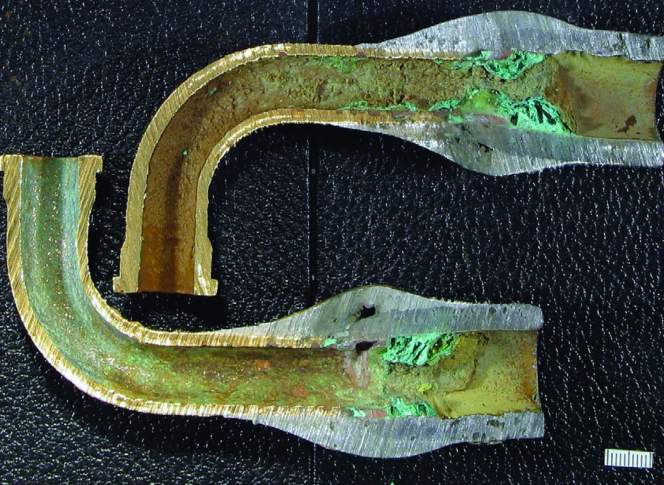Drinking Water Travels Disparate Paths In Wisconsin Utilities
About 39 percent of Wisconsin's households get their drinking water from private wellswhile most of the rest of the state's 5.7 million people rely on public utilities for this basic necessity. But utility customers across Wisconsin get their water on very different terms.
May 23, 2016

Gooseneck pipes

About 39 percent of Wisconsin’s households get their drinking water from private wells while most of the rest of the state’s 5.7 million people rely on public utilities for this basic necessity. But utility customers across Wisconsin get their water on very different terms.
The state Department of Natural Resources and Public Service Commission regulate more than 600 municipal water utilities. Each utility is subject to state and federal rules that govern how they operate and monitor water for contaminants, which are primarily set out in U.S. Environmental Protection Agency regulations and the Safe Drinking Water Act. Among the most important regulations are the Lead and Copper Rule, governing reduction of lead and copper, and the Ground Water Rule, which addresses disease-causing microorganisms.
The EPA generally delegates the day-to-day work of enforcing of these regulations to state-level agencies like the DNR. The rules give utilities a great deal of discretion to use or not use different water treatments — including disinfection for pathogens (protozoa, bacteria and viruses), fluoridation to prevent tooth decayand corrosion control to inhibit lead and other metals in pipes from leaching into drinking water. As a result, utilities across Wisconsin use varied combinations of treatments, and more than 50 use none at all. And this isn’t even taking into account the large number of rural Wisconsinites relying on private wells, who essentially have to act as their own utility managers and aren’t subject to regulations on monitoring or treatment.
Different utilities around the state have handled different contaminants in their water supplies, said Kevin Masarik, outreach specialist with the Center for Watershed Science and Education. The center is a partnership of the University of Wisconsin-Stevens Point College of Natural Resources and the UW-Extension. For example, Madison dealt with manganese and Waukesha with radium.
To some extent, differences in utilities’ treatment practices result from inherent chemical, mineral and biological differences in source water around a hydrologically rich state. Groundwater-sourced utilities in Wisconsin draw on one of four kinds of aquifers, layered in a complex configuration such that only one, the dolomite aquifer in eastern Wisconsin, corresponds neatly to a geographic portion of the state. Wisconsin utilities also rely on surface water from three lakes: Michigan, Superior and Winnebago. Moreover, different areas of the state have significant naturally occurring deposits of elements that pose a risk to human health, including arsenicand radium.
Problems like these become ongoing concerns that each utility has to manage.
“In a lot of times, with community water supplies, the solution is some sort of treatment, which doesn’t really solve the problem,” Masarik said. “It creates good water quality for community members, but rarely have they been able to address the problem at its source.”
But more than differences in geography and chemistry drive the varied practices of Wisconsin’s public water utilities. Their actions also hinge on their financial and staff resources, local politics, differing attitudes toward science among the public and municipal leaders, and knowledge gaps about drinking water contaminants and their impacts on human health. One can gain some perspective on the discrepancies in how Wisconsin utilities treat drinking water through the ongoing tales of two contaminant types: pathogens and lead.
Disinfection highlights old attitudes, emerging knowledge
Wisconsin doesn’t require utilities to disinfect their water to eliminate pathogens, though federal regulations do require those using surface water to disinfect. In 2009, the DNR began promoting new state regulations to require universal disinfection, but Wisconsin’s Republican-led state Legislature struck those rules down in 2011. The 56 municipal water utilities in Wisconsin that do not disinfect their water serve just more than 1 percent of the state’s population, almost 65,000 people.
Most are small rural water utilities in northwest Wisconsin, covering only a few hundred people each. But this list does include some larger municipalities, like Rice Lake (about 8,300 people), likewise in the northwest portion of the state, and Kewaskum (about 4,000), north of the Milwaukee area. While most of these utilities are on record as conducting no water treatment at all, they’re not all alike in their approach: A few have disinfected their water at points in the past, and some engage in other treatment processes, including fluoridation, corrosion control, and iron and manganese removal.
The common thread among Wisconsin’s non-disinfecting utilities is that they rely pretty much entirely on groundwater wells instead of lakes. And here is where public perception comes into play.
“The view [is] that groundwater is pristine,” said Mark Borchardt, a research microbiologist with the U.S. Department of Agriculture’s Agricultural Research Service. “And it really does vary. There are some situations where groundwater is very, very, high quality … We [also] know that vulnerability in groundwater varies quite a bit.”
Scientists are really just beginning to understand that pathogens can leach from manure on farms, or escape from leaky sewers and septic systems, and make their way into surprisingly deep sources of groundwater. Borchardt and his colleagues have conducted extensive studies of groundwater-borne pathogens, using municipal wells in Wisconsin as their test subjects. A 2007 study found human enterovirus in two wells in Madison, revealing that viruses can travel deeper and persist longer than previously thought. It was the first study to establish the presence of such pathogens in confined aquifers.
“That was a real shock at the time,” Borchardt said.
Researchers went on to look at wells and incidences of gastrointestinal illness in 14 Wisconsin communities that at the time were not disinfecting their aquifer-sourced drinking water. They found each community had viruses in its tap water, and those communities with the highest levels also had the most frequent incidences of illnesses causing vomiting and diarrhea.
The question of how many of those illnesses can be attributed to the water remains unanswered: Researchers estimated 6 to 22 percent for adults, but as high as 63 percent for children younger than 5 years. These incidences of stomach bugs are nothing like a deadly epidemic, but their public-health consequences add up, said Kristen Malecki, an assistant professor of population health sciences with the University of Wisconsin School of Medicine and Public Health. Malecki has teamed with Borchardt and other researchers to reveal how hydrology and weather conditions affect the movement of childhood gastrointestinal pathogens in groundwater.
“If there’s somebody who doesn’t have health insurance and they’re showing up at the emergency room, we’re also as a society paying that cost,” Malecki said. “If it’s something you regularly monitor for and you put some treatment systems in place, you can eliminate some expensive visits to the health care system.”
Research like Malecki’s and Borchardt’s is groundbreaking, but both admit they are a ways from turning these discoveries into information useful for public health policy. Next steps include developing a more detailed understanding of how waterborne pathogens manifest as illnesses, and learning more about how environmental factors, like rain, speed up pathogens’ journeys into groundwater. Their studies generally conclude that utilities should disinfect their water and cities should keep their sewer infrastructure in better shape, but Malecki pointed out that regulations and upkeep often lag science.
“Most of the regulations put in place for drinking water monitoring are in theory health-based,” Malecki said. “A lot of the monitoring components put in place are meant to protect public health, but things have changed over time, and the rules around water quality monitoring don’t always keep up with changes in the landscape and health risks.”
A lack of understanding about the health effects of contaminants is an obstacle not just for tackling pathogens but also for determining how to regulate chemicals in water, said Pat Planton, a long-time drinking-water consultant and chair of the Wisconsin section of the American Water Works Association, one of the primary professional groups for water utility staff.
“Our ability to measure chemicals to the parts per quadrillion, or even smaller [units] — we have the technology to do that, but medical science hasn’t caught up to know what these minute concentrations of chemicals do to the human body,” Planton said.
If research hasn’t immediately lead to new monitoring or treatment rules, it has spurred at least one Wisconsin water utility to voluntary action. The village of Prairie du Sac in Sauk County, with a water utility serving about 4,000 people, responded to the findings about pathogens in groundwater by installing disinfection systems on all of its wells. The utility opted for ultraviolet germicidal irradiation systems, which use ultraviolet light to destroy DNA in microorganisms.
Prairie du Sac village administrator Alan Wildman said UV disinfection might not be perfect — dangerous strains of E. coli can escape it, for instance — but its use helps the utility get around a persistent public aversion to chlorination.
“People expect water to be natural,” Wildman said. “At least in our area here, they see the UV as a compromise, as opposed to putting in some kind of chemical.”
In fact, Wildman noted, Prairie du Sac residents and officials approve of UV treatment so much that even if the village eventually was forced to chlorinate its water, it would continue using the UV systems as a backup. In a spring 2015 survey, the utility found that 57 percent of respondents supported using UV treatment with no chlorination, and 16 percent supported using a combination of UV and chlorination.
However, in other Wisconsin localities, groundwater studies have met resistance, Borchardt said.
“There’s two communities I’ve been told not to step into,” Borchardt recalled, declining to specify which ones. “Let’s just say I was physically pushed at one point.” And different people across the state have varying attitudes toward science itself, with some, he said, perceiving it as “more of a belief system than an evidence-based system.”
Of course, not all small water utilities greet Borchardt’s work with outright hostility, but most make do with limited budgets and staff time. In many small communities, the water utility not only lacks engineers, but it may not even have a dedicated full-time manager.
“A lot of these folks that are managing the drinking water are also managing everything else in the city,” Borchardt said. “They’re responsible for wastewater, lighting, streets. It’s absolutely remarkable how many responsibilities they have.”
Over the long run, Borchardt and Malecki hope their work enables water utilities to take a more preventive approach, one that ideally keeps pathogens from seeping into groundwater wells in the first place. The vast majority of public water utilities in Wisconsin do disinfect their water, and Borchardt noted that chlorination has saved lives around the world by clamping down on the spread of diseases like typhoid and salmonella.
“It’s an absolutely amazing public health feat,” he said. But it’s not one that every community in Wisconsin has embraced.
“For my entire career here in Wisconsin, the biggest surprise is that poop is political,” Borchardt added. “You can quote me on that if you like. Poop is highly political.”
Lead lingers
Water engineers dating back to ancient Rome favored lead pipes because of the material’s malleability and durability. But since at least the 1850s, scientists and public-health officials have known that this metal can leach into the water from pipes and create a significant public health threat. Most U.S. water utilities phased out installation of new lead pipes by the mid-20th century. But older lead pipes remain in use, mostly in the form of service lines, which carry water from a utility’s primary pipes into individual buildings. Often that lead service line is partially the utility’s property and partially the homeowner’s property.
State and federal officials do not know exactly how many lead service lines remain in Wisconsin’s drinking-water systems. One EPA report estimates 176,754 lead service lines are in use in 113 communities. But those numbers come with a caveat: The prevalence of lead services can be over- and underestimated. “In past surveys, many systems reported that they do not know if they have lead service lines in their system,” the commission report noted.
Of the Wisconsin utilities known to have lead service lines, at least 38 (which are completely different from the 57 that do not disinfect their water) do not use common corrosion control practices, an analysis of records in a DNR database shows. (Note: WisContext discovered discrepancies between information in the database and treatment practices water utilities said they were carrying out, either in response to queries or via their websites and other public-facing information. These differences were brought to DNR’s attention, and treatment practices independently verified where possible.) Those practices usually involve adding chemicals like phosphates to the water, raising its pH so lead and other metals in pipes won’t dissolve into the water supply. Water with a lower pH (which is more acidic) has a greater tendency to react with lead to create compounds that dissolve and carry the toxic metal into a consumer’s bloodstream. Many other factors, including other chemicals and water temperature, can influence whether such reactions occur.
The Lead and Copper Rule requires all drinking water utilities to monitor their water for lead. Overall, 72 of the 113 utilities in Wisconsin known to have lead pipes had at least one sample since the start of 2010 showing lead levels above the federal and state “action level” of 15 parts per billion, according to records in the DNR database. Most of these utilities had fewer than 10 such samples, but there are a few outliers, the biggest being Lake Mills in Jefferson County, with 74 samples exceeding the action level since 2010. Most utilities with lead pipes and high instances of lead-contaminated samples, including Lake Mills, do practice corrosion control.
u200bOne approach is to invest in the wholesale replacement of lead service lines, which the city of Madison did in an ambitious project from 1995 to 2012, phasing out city-owned lead pipes and partially reimbursing thousands of property owners to completely replace lead service lines. But few municipalities have taken on such a project, and most opt to minimize leaching through corrosion control. Other cities, like Beloit, work to gradually replace lead services during road construction projects, taking advantage of the fact that crews will be digging up infrastructure anyway.
It’s easy to see why: Madison spent $15.5 million on this effort, whereas chemical corrosion control is a much smaller up-front cost that has the economic advantage of helping pipes last longer. Some utilities have undertaken partial lead-service line replacement, essentially replacing the segment of lead pipe on city property, but leaving the segments on private property intact.
Both approaches can backfire.
Like any treatment, corrosion control can produce different results depending on the source water chemistry and the other treatments a utility applies. For instance, chlorine added as a disinfectant can make water more corrosive, creating a dilemma that a 2000 study on chlorine and corrosion summed up thusly: “Two regulations from the U.S. Environmental Protection Agency (EPA), the Lead and Copper Rule and the Ground Water Rule, seem to work against each other, even though each rule is meant to benefit the public.” And a new report from the Wisconsin Center for Investigative Journalism exposes other shortfalls in lead regulations and mitigation practices in the state.
Many studies, including in Madison and neighboring cities, have shown that adding certain phosphates for corrosion control can elevate lead levels under specific conditions. Still, when done appropriately, corrosion control is “the most cost-effective regulation, probably, in U.S. history,” said Marc Edwards, an environmental engineering professor at Virginia Tech and lead-control expert known for his outspoken approach.
“You’re protecting your pipe system, you’re protecting the pipes in people’s homes, and most studies have found that for every dollar spent, it saves $5 to $10 on watermain corrosion costs because the pipes last longer,” said Edwards.
Edwards has recently been very active in Flint, Michigan, where residents were exposed to extensive lead and pathogen contamination after state-appointed city managers switched its drinking water system’s main source from Detroit’s water utility to the Flint River. Edwards’ research showed that treatment processes intended to soften Flint’s water actually made it more corrosive.
Partially replacing a lead service line can also aggravate the problem it is intended to solve.
“If you disturb this lead pipe that has been sitting in the ground in many cases for a half or even a full century, you’re knocking lead rust off that pipe at hazardous-waste levels,” Edwards said. And connecting an old lead pipe with a new copper pipe creates what Edwards called a “galvanic cell” — essentially a set of electrochemical conditions that draws more lead into the water. “If you replace half a lead pipe and connect it to copper, you can easily have 5 to 10 times more lead in the water,” he added.
Public health experts have questioned the effectiveness of lead-mitigation practices and of the EPA’s Lead and Copper Rule.
In a 2012 journal article surveying numerous peer-reviewed studies about lead exposure through drinking water, Centers for Disease Control and Prevention researchers Mary Jean Brown and Stephen Margolis reported that lead levels in drinking water have decreased significantly since the EPA began to enforce the Lead and Copper Rule in 1991. They also noted these regulations won’t entirely prevent dangerous conditions: “A system with lead service lines that is in compliance with LCR can still expose children to lead levels u226515 ppb because LCR permits u226410% of sampled homes to exceed the action level of 15 ppb,” Brown and Margolis wrote. “Optimized corrosion control also might not completely prevent lead in plumbing materials from dissolving into drinking water. Persons who drink water from these sources might be exposed to lead levels >15 ppb.”
Even for the very few utilities that have replaced thousands of lead services — Madison and Lansing, Michigan, have been among the most aggressive in the country — it’s not all water under the bridge.
Joseph Grande, water quality manager for the Madison Water Utility, says naturally occurring manganese in some Madison wells can intensify trace amounts of lead in the source water. Manganese can accumulate and form scales inside pipes. Those scales then absorb lead, trace amounts of which can add up over time and eventually leach back into the water. Madison’s utility periodically flushes out its pipes to mitigate manganese buildup. Additionally, while the effect of a lead service line is generally confined to the building it serves, there’s no way for the city to know for sure that it’s replaced every single one, short of digging them all up. In a recent interview with Wisconsin Public Television’s Here And Now, Grande explained the regulatory triggers and decision-making that led to Madison’s years-long replacement project:
Lead also complicates water conservation. When customers use less water, that remaining in the system sits in the pipes longer, offering lead more opportunity to leach into it. “Systems can’t just go blindly into water demand reduction or conservation plans,” said Gregory Harrington, a UW-Madison professor of civil and environmental engineering. Lead’s relatively small part in the water system infrastructure highlights some of the long-term decisions ahead for water utilities — including Madison’s, which has about 900 miles of pipe, much of which is at least 50 years old. “I think the biggest decision they’re going to have to make is how to fund infrastructure over time,” Harrington said.
Like Mark Borchardt of the Agricultural Research Service, Grande noted limited staffing of small utilities as a challenge to improving water treatment practices. A large utility like Madison has the engineering staff and money to test out corrosion control strategies before implementing them.
“I think for a small utility [where] the manager of that water utility might also be the person who’s responsible for trash collection or street repairs and the like may not have the technical knowledge and is at the whim of a salesman who says ‘I have this magic potion that’s going to fix your lead problem,'” Grande said. “They have to trust that this chemical is going to be something effective, but from my experience it’s something that warrants testing beforehand.”
This scenario highlights how municipal officials make choices about each treatment for Wisconsinites’ drinking water. Those choices may involve science-based best practices, budget considerations, the requirements of regulators, public perceptions, or most likely some mix thereof.
Drinking-water consultant Pat Planton said the people who drink the water play the most important role in driving these decisions.
“It’s just an issue of how good of water quality do you want,” he said, “and how much are the ratepayers willing to pay for that?”
 Passport
Passport











Follow Us